Stories of events and happenings at the once very popular Bartold’s Grove could easily furnish enough material for a few books if we could only recover them somehow. I have made a few blog posts about this historic inn in the past. The most recent two were posted in 2016. If you care to refresh your memory, here are the links.
Recently Clark Hickman, a former Maplewoodian whose name many of you may recognize, found an interesting article while scrolling through copies of The News-Champion newspaper that are on microfilm at the Headquarters Branch of the St. Louis County Library. He kindly passed it along. The News-Champion was published in Maplewood.
The article originally appeared in the May 3, 1931 edition of the Globe Democrat which had allowed the Champion to reprint it. It is a very interesting article. I encourage you to read it. I’m going to attempt to reproduce the original article here. This is always an iffy proposition so bear with me.
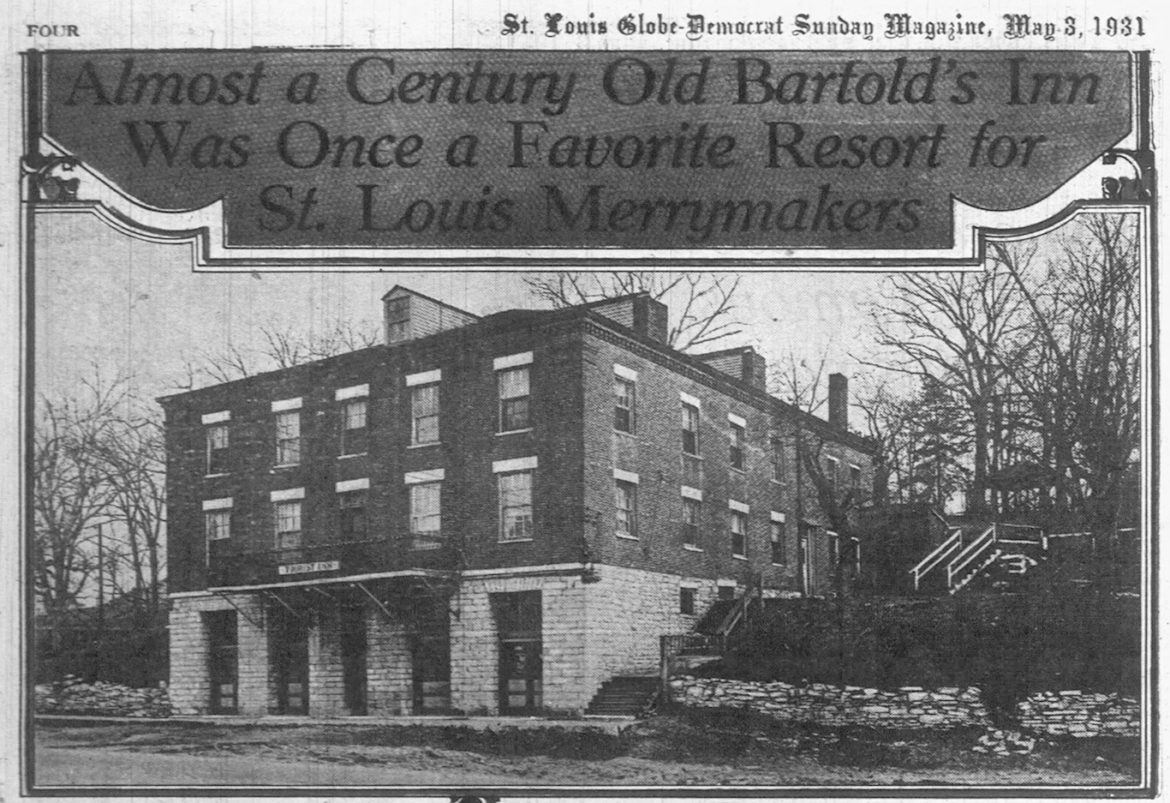
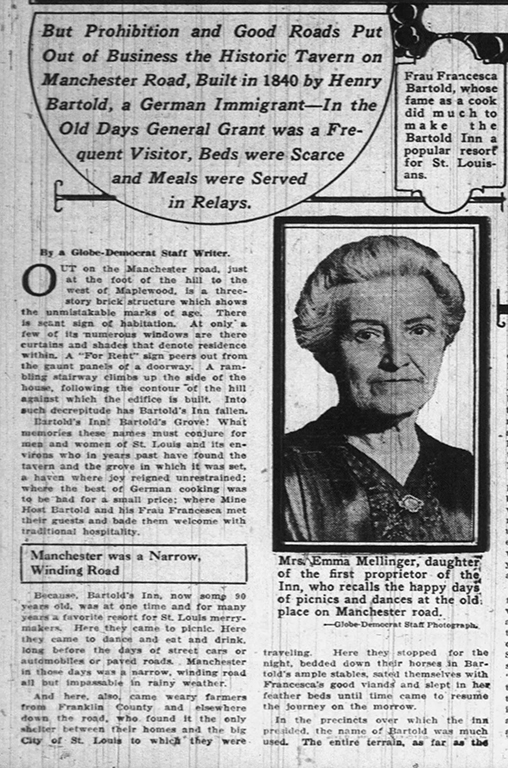


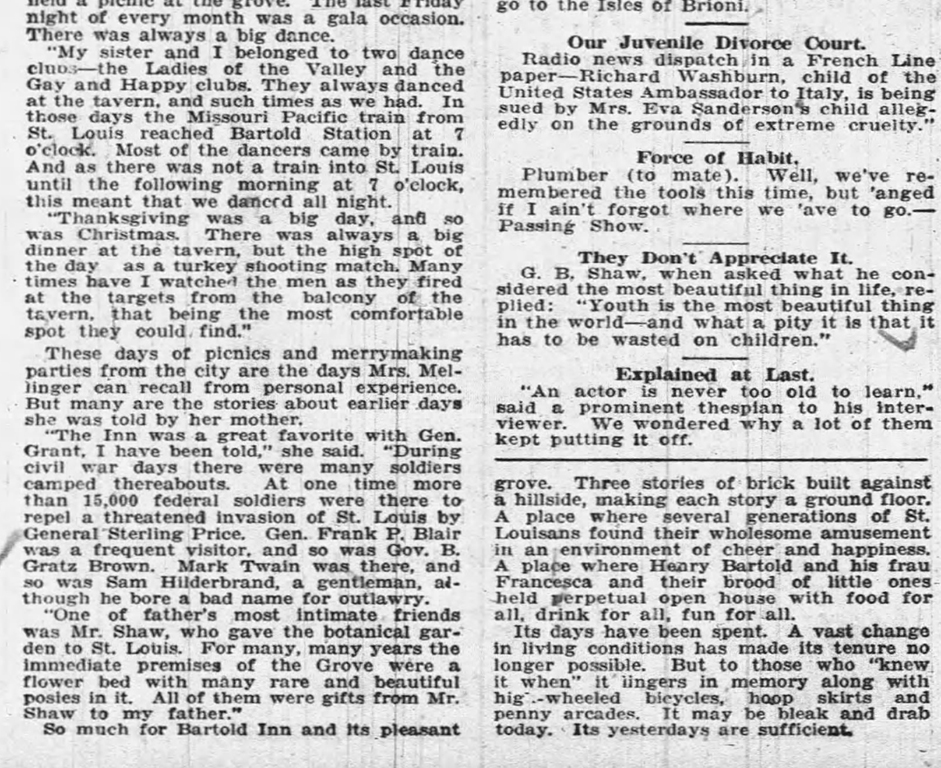
My apologies for the different sizes of type. To try and have them all come out the same is not worth the trouble.
This is a terrific story. Just above are only a few of the famous people who must have visited or stayed at Bartold’s. But what a line up. Grant and Twain! Wow! And probably at the same time. Henry Shaw may have been the wealthiest person in St. Louis and was a friend of Henry Bartold’s. What a shame this building and site no longer exist. If it did, don’t you think it would be a major attraction such as White Haven? Of course it would. To top it off, it was located on what would one day become the very first alignment of the now mythical highway, Route 66.
Now comes the surprise. Larry Giles of the National Building Arts Center has made us a gift. It is an original oil painting done of the Bartold Inn by a man named Ernst Eve. Larry grew up in Maplewood. I believe he said it was about 1960 and the building was derelict – opened to the elements. He decided to explore it just as many young folks would. He found this painting in a back room. He has preserved it for the last 60 years! The painting comes to us from the collection of the National Building Arts Center. It will become part of the collection of historic material at the Maplewood Public Library.
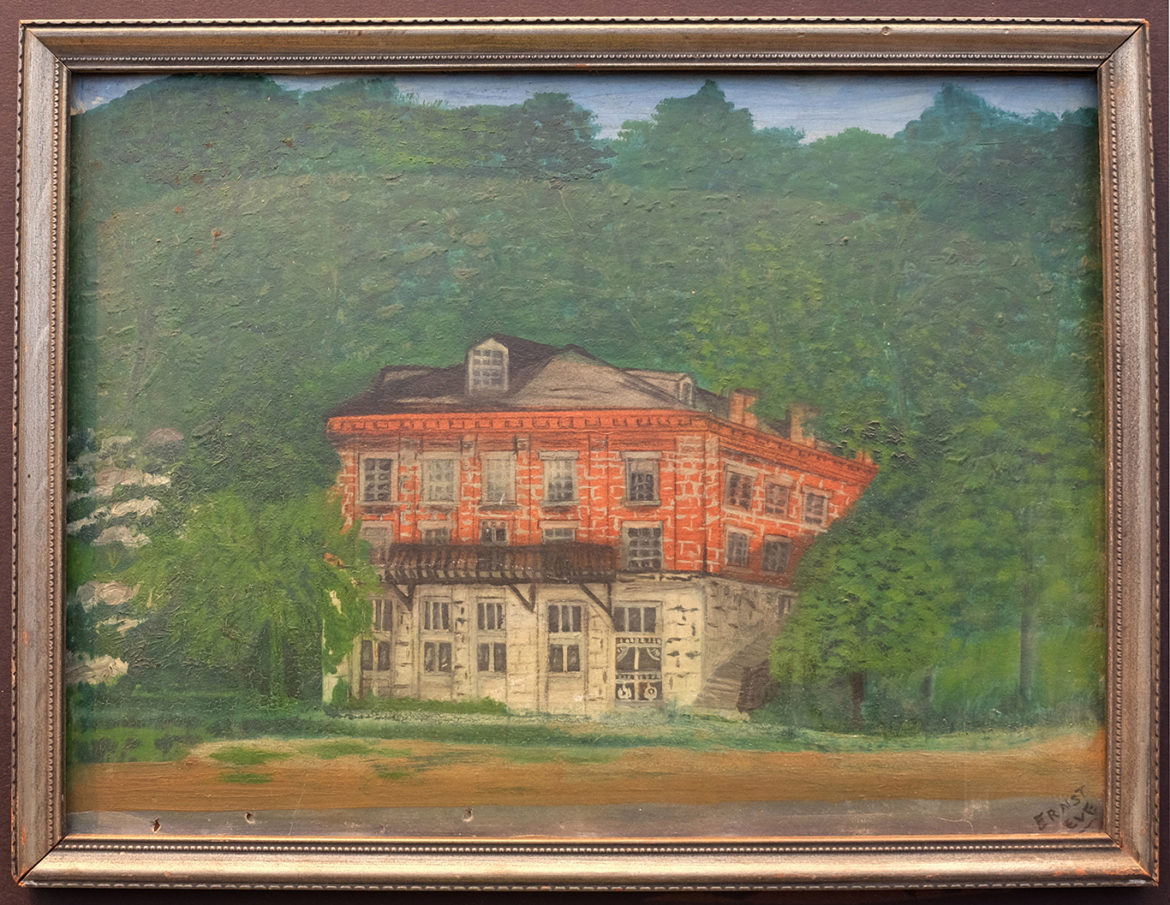
This a genuine piece of Americana. I have no idea how old the painting is. It was painted on a piece of Hi-Art Artist’s Illustration Board. The fact that Larry found it about 1960 means it was probably fairly old by then. Nothing is yet known about the painter, Ernst Eve, either. I wonder if there are some other paintings done by him somewhere?
A cursory search turned up nothing on the artist. As for the board there is a product called Peterboro Hi-Art Illustration Boards. Apparently the board is still being produced. A history of the company might give us some idea of when the painting was created. Let us know if you find anything.
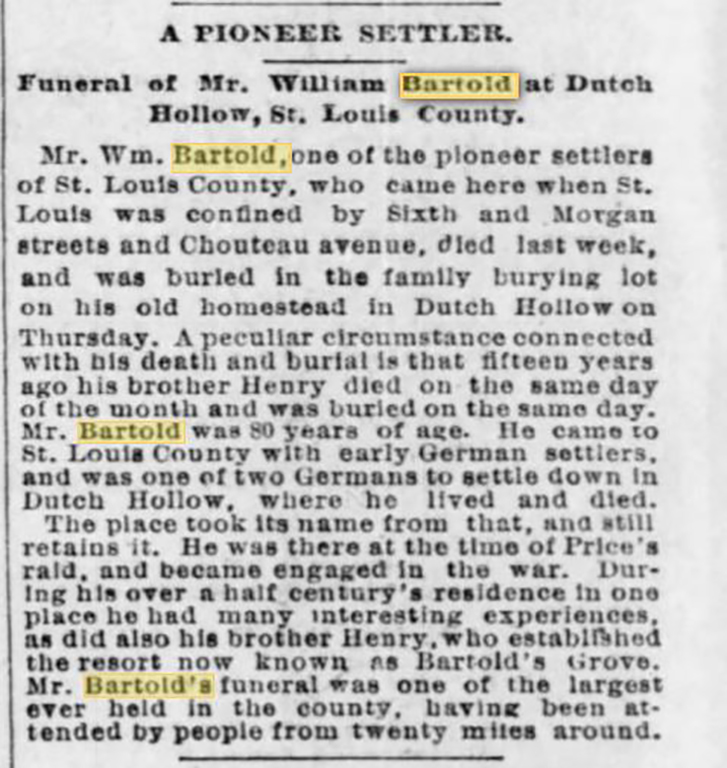
It would be interesting to know why when Henry’s brother, William, died it was one of the largest funerals ever held in St. Louis County. More research is needed.
As always, I am very grateful to everyone who contributes material to this effort. The readers comments generally add a great deal to our understanding of what life must have been like back in the “good ol’ days.”
I especially want to thank Larry Giles of the National Building Arts Center for his gift of this historic painting. If you are unfamiliar with the National Building Arts Center, you would do well to take a look at their website here. I am planning a blog post about them in the near future.
Stay healthy, everyone.
Doug Houser March 27,2020
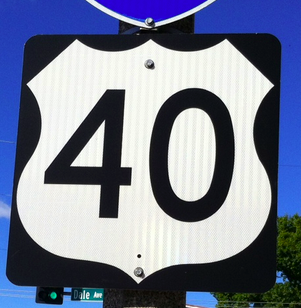
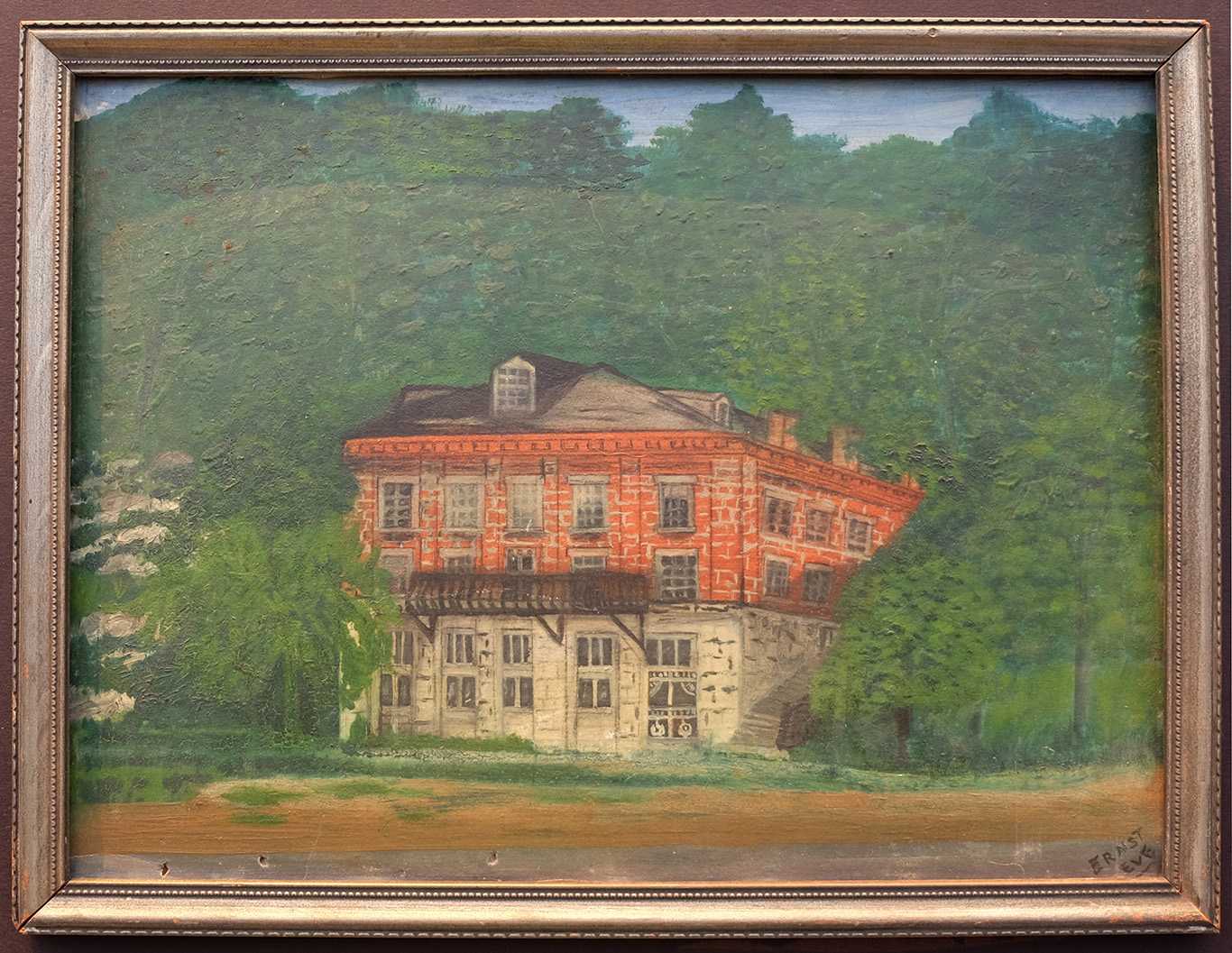
Doug, Do you, or any of the readers know the location of his burial? It says ‘Dutch Hollow” and since they were heavily tied to the Manchester area also, would that be the area now know as “Dutch Mill” near 141 and Manchester? I’d be curious to know if the family graves are still around.
Bill
Bill, No, Dutch Hollow is not by Dutch Mill. Dutch Hollow is now referred to only as Hollow and is in Wildwood. His old property currently has a street named Windy Hollow Ln. running through it. This land is next to the Wildwood Historical Society and Stovall’s Grove. Also, from Stovall’s Grove to the North across Manchester one finds Bartold Ln. named after the family.
William’s farm was large and the family cemetery was on his property. At some point the family burial plots were moved to the Bethel Cemetery in the nearby town of Pond. William’s tombstone has a record of his service as an union solder and his wife, Henrietta nee Bankelberg has an equally interesting old ornate tombstone (pictures of both can be found on findagrave.com).
Dave P.
Maybe that painter’s name was Ernst Ele instead of Eve? The letters go every kinda zigzag.
There’s an idea. Might also have been an abbreviation or possibly his nom de paintbrush. Thanks, Tom.
Thank you Clark Hickman for sharing this article what a fun find. However, I would like to set the record straight on the origin of Bartold’s Inn.
In the year 1840, Henry Bartold would have been about 13 years old and his wife Franciska (nee. Oberfell) would have been about 3 years old, both were born in Germany. The earliest document I have found so far for Henry in the US is his naturalization record from April 2, 1857 in St. Louis County. So Henry did not build Bartold’s Inn around 1840…
The records found so far indicate Henry’s older bother (by 10 years) Frederick Bartold purchased the land and built the first structures that would become Bartold’s Grove. Frederick was a very successful business man. He not only developed the Bartold’s Grove into a famous resort he also had multiple business ventures in Manchester City. In Manchester, another Bartold brother named Louis owned a large coffee house/hotel, while Frederick had a tavern and mercantile store that would later add a mill. In 1855, Frederick platted land he owned in the heart of Manchester into a large subdivision named “Bartold’s Western Addition to Manchester”. This subdivision is now apart of the Henry Avenue Historic Distict in Manchester (and yes the street is named after Henry Bartold). There is also a second street in the District named after Louis.
The earliest date for Frederick in the US I have so far is the birth of his oldest child Wilhelmina during 1843 in New Orleans. Which corresponds with William Lyman Thomas’ account (on page 337 of the book History of St. Louis County, Missouri Volume 1, 1911) that the large brick building known as Bartold’s Inn was constructed around 1849 by Fredrick Bartold, and thus, not 1840 by Henry Bartold as the Globe-Democrat article suggests. Frederick sold Bartold’s Grove to Henry sometime before his untimely death in 1858 at age 41 according to probate records.
Outstanding, Dave! We truly appreciate your ability to add to and, in this case, correct the record. Fascinating stuff, as always. Good job!
What a neat old building to have lost. Too bad it is gone. I have to wonder how much that structure cost to build even way back then. Lots of brick, stone and windows that you can see then you read about all the rooms, the kitchen, the dance hall. I guess I have too much time on my hands some days but I recently watched some of the guys who go around metal detecting old homesteads. Wonder if there would be anything to ever recover there. Would be interesting to find a few artifacts from that era there.
I agree with you, Mark. It truly is a shame to have lost such an important historic building. I’m 99% certain there is nothing from the original building or site to be found by metal detecting. The building once existed on the slope just below Sunnen’s complex on top of the hill. I’m not exactly sure where the “grove” part of the business was. I have a dim memory of reading somewhere that there was a beer garden on top of the hill. I believe they must have swum in Deer Creek. I haven’t found any record of what other sort of amenities existed. Certainly it had to be in a parklike setting – picnic tables, small shelters, pavilions, that sort of thing. You can get some idea of it from the drawing on the old postcard that is reproduced in the first link above. The main reason I think you wouldn’t find anything is part of the site was probably destroyed when Hanley was extended south of Manchester.
Doug, I have often wondered at some of the stories about people fishing and swimming in Deer Creek. I have not walked a lot of it and do not know how things have changed with how much water is in the creek from then to now. But unless someone dug out part of the creek or there were some much larger deeper holes that no longer exist I have often wondered about how much actual fishing and swimming was done there. I know the way the thing can flood that it can carry a lot of water but most of the time it seems to me that I do not know if I have ever seen a spot much over 2 feet deep which could hold a few frogs, turtles, snakes and maybe a few smaller fish but not what I would be calling a swimming or fishing creek. Are there any actual pictures of it showing lots of folks swimming in the creek that you have found?
Hey Mark, I grew up in the country swimming (We called it that anyway) in many creeks much like Deer Creek. The water was mostly very shallow with the occasional deeper hole here and there. I know for certain that Deer Creek was fished in. I posted a photograph of some fellows carrying their gear in one of my past posts (At the moment I’m not remembering which one). I don’t have any photographs of people swimming in Deer Creek. I remember reading a newspaper article about a boy who drowned there. Bill Jones also tells a story of how he almost drowned in Deer Creek.
https://40southnews.com/maplewood-history-first-grade-deer-creek-adventure-by-bill-jones/
Hope this helps. Thanks for your questions and comments.
I lived on Bartold Ave. for 20 years before Sunnen bought us out. Nice to read about who the street was named after. Great article.
Thank you, Mark. I’m glad to learn the article had meaning for you. Thanks for taking the time to comment.
Doug, Do you know exactly the location or today’s address? It looks like there is a tall hill behind it, possibly near Manchester/Hanley?
Most definitely. It was very close to where the Metrolink station on Manchester is today but on the southern side of the street. The Sunnen complex sits directly on top of what was once Bartold’s Grove. Take a look at the link to Bartold’s Grove above in the first few lines. There is more information on that and a photo. Good to hear from you, Doug.
This is a fascinating account, Doug. Thanks for your hard work on behalf of preserving the history of Maplewood.
It is my pleasure, Ralf. Glad you liked this.
Comments are closed.